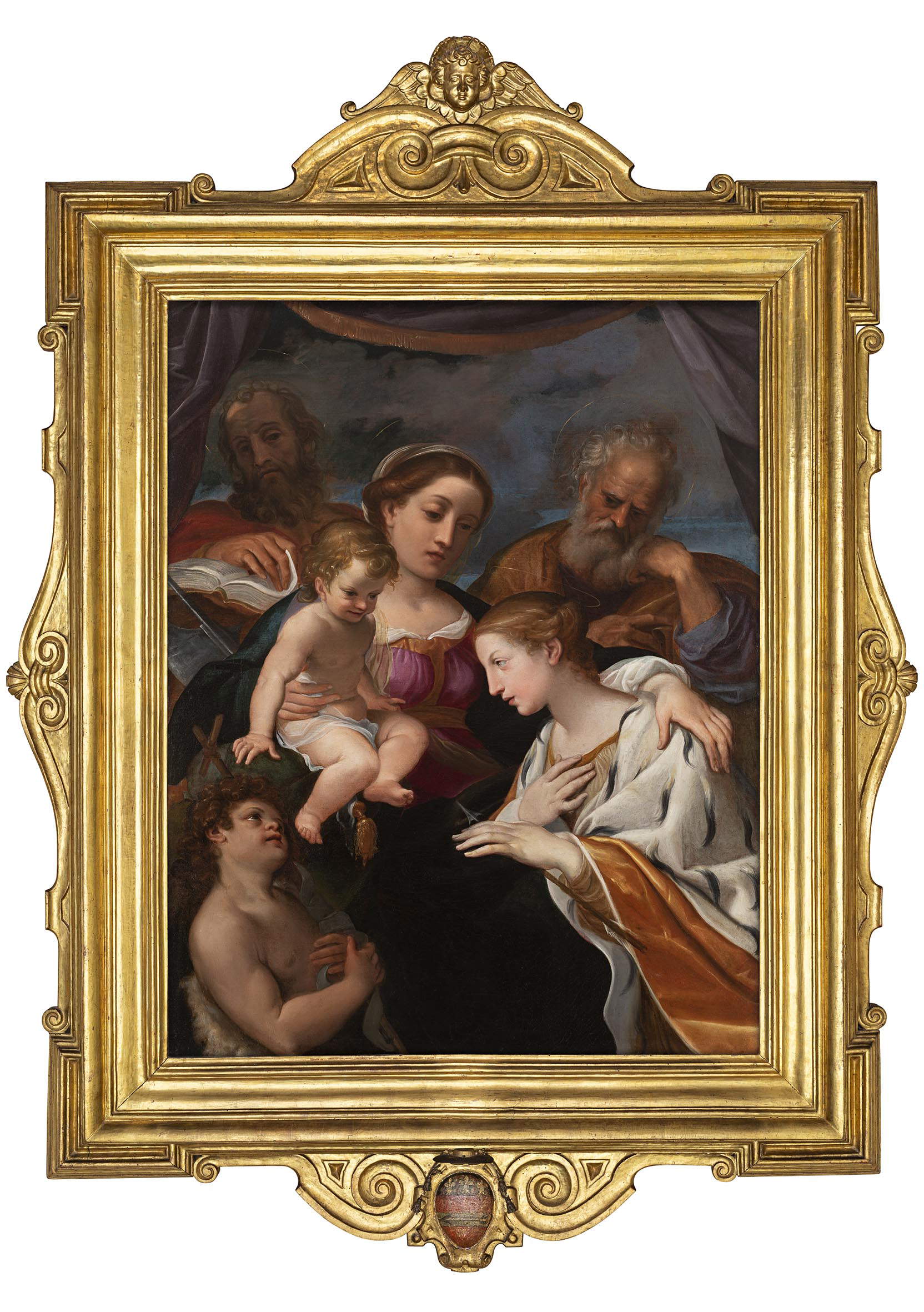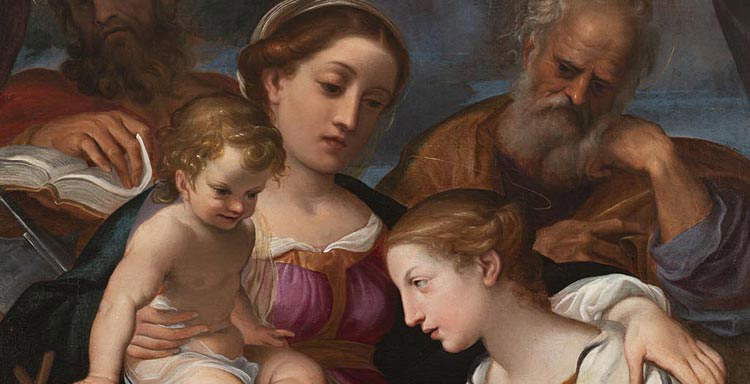Pinacoteca Nazionale di Bologna acquires important work by Ludovico Carracci
The Pinacoteca Nazionale di Bologna is enriched with a new work, the Holy Family with Saints John, Ursula and Matthias by Ludovico Carracci (Bologna, 1555 - 1619). The work joins the significant nucleus of 23 canvases by the Bolognese artist already preserved in the Pinacoteca and represents an important opportunity to fill a gap in the collection. It is in fact a room painting, intended for private devotion, of very high quality and important dimensions: the Pinacoteca’s collection had no similar works by Carracci, and this new arrival further documents the great artist’s career. The work is placed in the early seventeenth century, in Ludovico’s “classicist” season of which no other examples are preserved in the museum’s collections.
The work, from the Bonfiglioli Malvezzi Campeggi collection, was acquired by the Ministry of Culture in 2022, through the right of first refusal exercised following the export request submitted to the Soprintendenza Archeologia, Belle Arti e Paesaggio for the metropolitan city of Genoa and the province of La Spezia. The acquisition was made possible thanks to the concurrence of funds from the General Directorate of Archaeology, Fine Arts and Landscape - Service IV Circulation and the General Directorate of Museums, activated following the attributive confirmation by art historian Alessandro Brogi.
The provenance of the painting from the Bolognese Bonfiglioli collection was identified from the studies of Alessandro Brogi himself and from the inventory of the collection dated 1757, transcribed by Giuseppe Campori and published in 1870 within the volume Raccolta di cataloghi ed inventarii inediti di quadri, statue, disegni, bronzi, dorerie, smalti, medaglie, avorii, etc. from the 15th to the 19th century. The Bonfiglioli family owned 11 works by Ludovico Carracci, including paintings and drawings, all of which have been dispersed or lost: the Holy Family with Saints John, Ursula and Matthias is attested as the only one currently known.

As soon as it arrived at the Pinacoteca, the painting underwent restoration at Manuela Mattioli’s workshop. Beneath the now yellowed layer of varnish, Ludovico Carracci’s stylistic peculiarities emerged in their integrity, the brilliant colors, the executive refinement of the robes, particularly Orsola’s cloak, the scenic layout marked by the curtain that opens the scene onto the sky crowded with clouds. The emotional temperature of the painting has been recovered in which the great Bolognese painter’s typical poetics of the affections finds expression in the intimate conversation between the characters depicted, in Mary lovingly wrapping her arm around Saint Ursula’s shoulders, in Saint John in adoration of the little Jesus, himself a very human and lively child, to whom the restoration has restored the admirable overhang that sets him apart within the composition. The domestic atmosphere is perfectly aligned with the painting’s private destination and constitutes a particularly brilliant example of this devotional typology to which Ludovico aspired throughout his long artistic career, at the same time as he created the great altarpieces of ecclesiastical destination that contributed in a special way to his celebrity.
The cleaning also made it possible to arrive at the correct interpretation of the subject, which is not the Mystic Marriage of St. Catherine, as indicated in the deeds submitted for export authorization, but a Holy Family with Saints John, Ursula and Matthias.
In the restoration workshop, ancillary decorations on the frame, which can be traced back to the 19th century, were removed, concealing the correct reading of the artifact, which is authentic and coeval to the painting. The intervention also revealed the Bonfiglioli coat of arms, further confirming that it belongs to the prestigious Bolognese collection.
"The acquisition of the Holy Family with Saints John, Ursula and Matthias by Ludovico Carracci," says Maria Luisa Pacelli, director of the Pinacoteca Nazionale di Bologna, “represents a great success for the entire Ministry of Culture. It was, to all intents and purposes, a successful team effort that involved, in addition to the Pinacoteca, the General Directorate for Museums, the General Directorate for Archaeology, Fine Arts and Landscape, and the Soprintendenza Archeologia, Belle Arti e Paesaggio for the metropolitan city of Genoa and the province of La Spezia. On this occasion I would like to thank all those who were active during the acquisition process and allowed us to enrich the collections of the Pinacoteca with such an extraordinary work.”
Ludovico Carracci (Bologna 1555 - Bologna 1619), between 1570 and 1580 studied with Prospero Fontana and possibly Camillo Procaccini. It is likely that around 1575 he left his city for some time to travel and study between Florence, Parma, Mantua and Venice. In 1578 he was accepted into the company of painters in Bologna. His early works already reveal that great inventive ability to interpret religious themes that is a constant feature of his painting: he was, of all the Carraccis, the most original in his iconographic choices and dramatic interpretations. When Annibale and Agostino moved away from Bologna (1594-95), Ludovico continued to run the workshop and the Accademia degli Incamminati, founded in the 1580s, and his work had a decisive influence on early 17th-century painting in the city and throughout Emilia.
 |
| Pinacoteca Nazionale di Bologna acquires important work by Ludovico Carracci |
Warning: the translation into English of the original Italian article was created using automatic tools. We undertake to review all articles, but we do not guarantee the total absence of inaccuracies in the translation due to the program. You can find the original by clicking on the ITA button. If you find any mistake,please contact us.




























